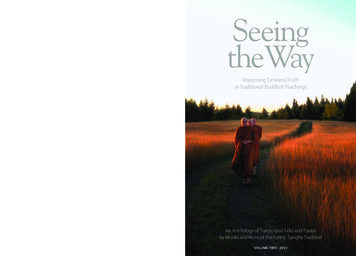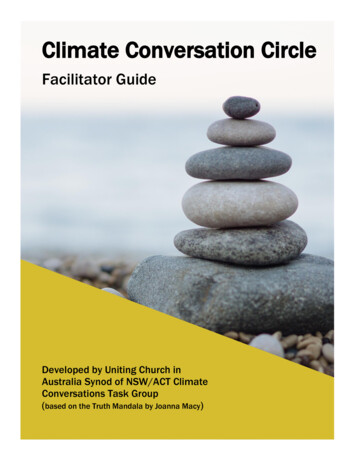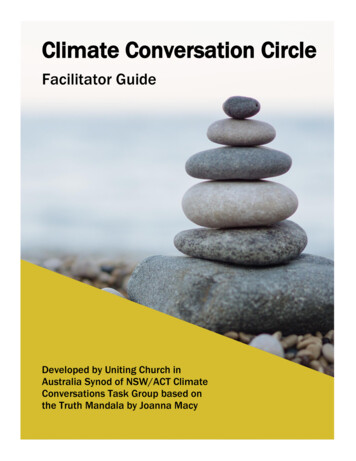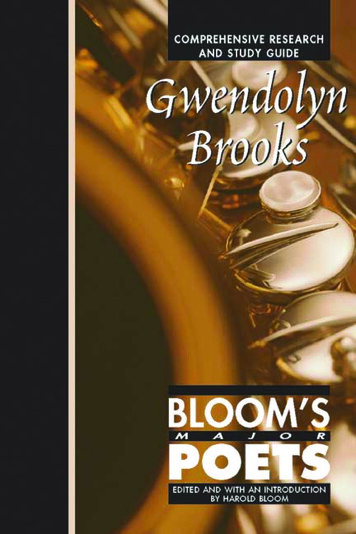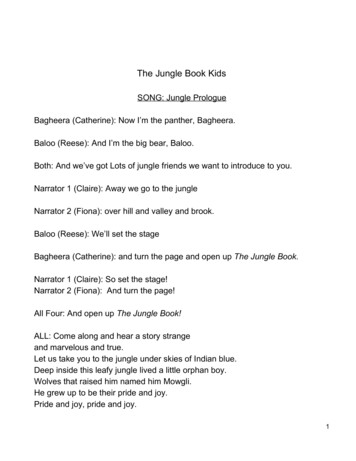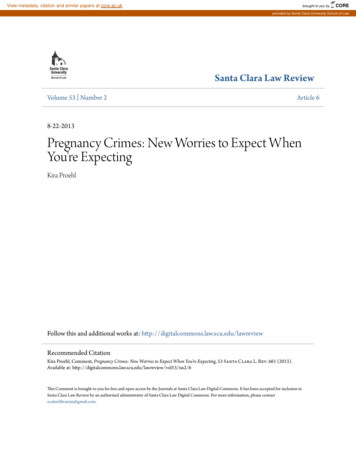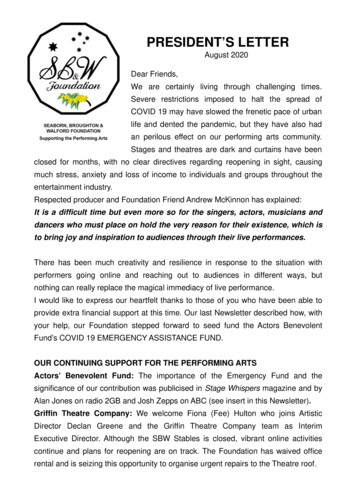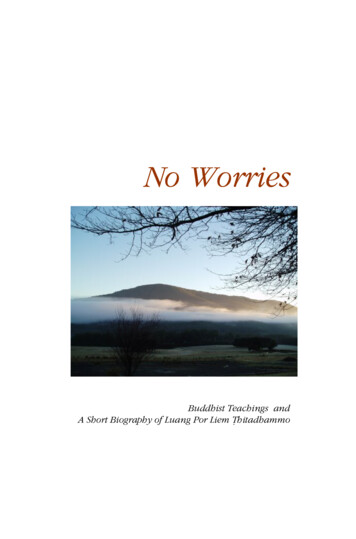
Transcription
No WorriesBuddhist Teachings andA Short Biography of Luang Por Liem Ṭhitadhammo
For Free Distribution onlyCover picture: View from Bodhivana Monastery, MelbourneCopyright by Wat Nong Pah Pong, Ubon, 34190 Thailand 2005 ISBN: 974-93324-9-02
Buddha image carved by Luang Por Liem as a young monk3
ContentsAbout Luang Por LiemForewordDhamma Teachings by Luang Por LiemQuestions and Answers with Luang Por LiemA Short Biography of Luang Por Liem ṬhitadhammoGlossary4page 5page 7page 11page 43page 74page 132
About Luang Por LiemLuang Por Liem Ṭhitadhammo1, a Buddhistmonk in the Thai Forest Tradition, was born in Sri SaketProvince in the Northeast of Thailand on the 5th ofNovember 1941. After higher ordination at twentyyears of age, Luang Por practised in several villagemonasteries throughout the Northeast until he joinedthe Forest Tradition in 1969. He took up the trainingunder Luang Pu Chah, who later became one of themost famous monks in the country, and whosereputation and influence has continued to spreadthroughout the world, even today. Living under LuangPu Chah’s guidance in Wat Nong Pah Pong, Luang PuChah’s monastery in Ubon Province, Luang Por Liemsoon became one of his closest disciples. After LuangPu Chah became severely ill in 1982, he entrustedLuang Por Liem to run the monastery. Shortly thereafter, as Luang Pu Chah’s illness prevented him fromspeaking, the Sangha of Wat Nong Pah Pong appointedLuang Por Liem to take over the abbotship. He fulfilsthis duty up to the present day keeping the heritage ofLuang Pu Chah’s Dhamma and characteristic ways of1In Thailand “Luang Por” is an affectionate and respectfultitle given to older monks and means “Venerable Father”. Ina similar way, the appellation “Luang Pu” or “VenerableGrandfather” is used for very senior monks and can confereven greater reverence and respect. “Ṭhita” is a Pali wordthat translates best as “stable” and is an epithet for Nibbāna.Luang Por Liem’s ordination name “Ṭhitadhammo” perhapsrefers to “insight into the stability of the principles ofDhamma.”5
monastic training available for monks, nuns and laydisciples.Shortly after his 60th birthday, almost ten yearsafter Luang Pu Chah’s death, Luang Por LiemṬhitadhammo was given the honorary title of Tan ChaoKhun Visuddhisaṁvara Thera2 by His Majesty the Kingof Thailand. For the Sangha at Wat Pah Nanachat(Luang Pu Chah’s International Forest Monastery fortraining non-Thai monks) Luang Por Liem is not only adearly respected teacher and guide in the monastic life,but has for the last ten years also conducted everymonastic ordination ceremony as the preceptor.Luang Pu ChahLuang Por Liem2“Tan Chao Khun” is an ecclesiastical title roughlyequivalent to a bishop. “Visuddhi” means “purity”, carriesconnotations of authenticity, completion and integrity and isanother epithet of Nibbāna. “Saṁvara” translates as“restraint” or “discipline”. It can refer to the mental qualitiesof non-grasping and detachment or to the sublime conductof one practising the Dhamma. “Thera” refers to an eldermonk in the Sangha.6
ForewordThe first half of this book is a compilation ofDhamma teachings of Luang Por Liem Ṭhitadhammothat were given during his visit to Australia in May 2004(2547) in various talks and conversations. The talkswere given in Thai with interruptions for translationinto English after each couple of minutes. Because ofthis unusual way of presenting the Dhamma in littlepackets, it seemed almost natural to pick some of thesepackets from throughout the trip and put them togetherwith little individual headings in this book, rather thanchosing one or two of the complete talks. We hopethat the editing, cutting and compiling will serve thepurpose of giving a fairly round picture of all thesubjects and similies that Luang Por mentioned duringthe over 30 talks and question and answer sessionsduring the three weeks of his visit.Luang Por was invited to Australia by BodhivanaMonastery in Melbourne, a newly established branchmonastery of Wat Nong Pah Pong, where he stayed formost of the time of his trip. Most of the Dhamma inthis book was given there, but some of it is also fromSydney, Bundanoon (Santi Forest Monastery), andCanberra (Wat Dhammadharo and the Royal ThaiEmbassy).The second half of the book is mainly thetranslation of parts of Luang Por Liem’s Biography inThai called “Ṭhitadhammajahn” (2002/2545).Theselected material outlines the development of LuangPor’s practice, so many of the interesting anecdotes andstories from the life of a forest monk in ruralNortheastern Thailand haven’t been included.7
The Thai Forest Tradition doesn’t emphasizedoctrinal theories, but rather application and practice.The translation therefore often faces the problem offinding the right balance between technical accuracyand a rendering of the spirit of what was said. Many ofthe technical terms in Pali also have quite a differentmeaning in the colloquial usage of the Thai language,in which the Dhamma talks of the Forest Tradition areusually given. Many of the readers might not befamiliar with the specific style of expounding theDhamma in the Forest Tradition, where the teacherstalk freely and unprepared, straight from the heart,coming from personal experience rather than ascholarly point of view. For any doubts or questionsarising, one is probably best advised to try and find outthe meaning behind the words through one’s ownpractice and investigation. This is very much in linewith one of Luang Por Liem’s favorite mottos:Observe and reveal it,Give it voice,Apply it, bring it to being.We hope that this book inspires many readers toput the Dhamma into practice. We’d like to apologizefor any shortcomings and faults that may occur in thispublication, and – last but not least – thank the manymonks and laypeople, whether at Wat Nong Pah Pong,Bodhivana Monastery, or Wat Pah Nanachat for theirhelp in this publication,the translatorsWat Nong Pah Pong, June 2548 (2005).8
“There is the state of coolness ,coolness in every position.All worries, concerns or similar thoughts fromthe thinking mind are totally gone.”9
10
Dhamma Teachingsby Luang Por Liemcompiled from various Dhamma talksduring his stay in Australia11
AdaptationIn the practice of Dhamma things progress bit bybit. It is not possible to force or hurry things in anyway, similar to how we build this monastery 3. If onewants to build a monastery, one needs to proceedgradually, bit by bit. One allows for adaptations andnew developments to take place during the course ofthe work. This also should be the attitude towardsDhamma practice. To accomplish everything in asingle day is probably impossible, so we need to gostep by step.I didn’t expect it to be too different here, asAustralia and Thailand are quite similar: that peoplesometimes start feeling either happy or unhappyshould be the same everywhere.Of course, how one feels under certain livingconditions also depends on the climate, but actually theweather only becomes something that we find difficultwhen our bodily resistance is weak. If we have builtup some resistance, there is nothing too hard about adifferent climate. To think that it’s too hot or too coldisn’t the point – it’s only a matter of adapting oneself.The same is true for the practice. One cannot expectone’s practice to always go well. One needs to lookfurther and see the practice as constant adaptation.3Luang Por is relating his feelings about BodhivanaMonastery, Melbourne.12
Whatever is insufficient one needs to correct, what isn’tgood one has to give up.But be aware, if one’s views are biased, one’sdevelopment won’t go in the right direction. Wheneverone holds biased views (agati dhammā), one still isn’taccomplished in the Dhamma.Take the example of somebody who sees anuneven, rough piece of land and considers it unsuitablefor use. That’s not correct. After adjusting the groundand re-leveling it, the land can be used. Even roughland can be used, if things are arranged appropriately.On the other hand, if things are not arranged well, thesmoothest and finest land will turn out bad.DukkhaDukkha4 in the Four Noble Truths can be dividedinto kāyika dukkha and cetasika dukkha, the dukkhathat arises from the body and the dukkha that comesfrom the mind. Dukkha of the mind arises because ofwrong view. It arises whenever the mind is taken overby unwholesome qualities such as delusion or craving.But when we contemplate bodily dukkha, werealize that it is something that we have to experienceconstantly in our bodies. One can say it is part of lifeitself. It has to be there. The bodily organism needing4Usually translated as suffering, unsatisfactoriness or stress.13
to excrete and urinate is dukkha. We experiencehunger and thirst as unpleasant feelings (dukkhavedanā), and the stilling of it as a pleasant feeling(sukha vedanā), but in fact, the whole process isnothing but dukkha.The dukkha that comes directly from the mindarises from the influence of wanting, or taṇhā.5 Taṇhāis a state of insufficiency. Just as the great oceans whichall the rivers flow into will never be full, so too taṇhāwill never be satisfied. The Buddha thus spoke theverse:There is no river like craving. (Dhp. 251)What is Left?When we practice mindfulness of the body, wefocus on the decay and ending of our body. We focuson seeing that the body does not endure and that itcan’t be what we call our self.Every day death keeps happening to us, but it’s ahidden way of dying, not the obvious death of thebody. One can see it in the fact that things change.We die from being a child when we become adults.This too is death. Even entering the period of life whenone’s body deteriorates and can’t be controlled aseasily as before is death. The various constituents of5Usually translated as craving or desire.14
life (khandhā) do what they are supposed to do andsimply fall apart. Earth goes to earth, water goes towater, fire goes to fire and wind goes to wind. Is thereanything left that we can take as belonging to us?Melting Away Like SnowTime passes relentlessly. The Buddhacompared us with cattle that are being pulled toslaughter. Everyday time passes. Our lifespan is like adewdrop resting on the tip of a blade of grass – or likethe fallen snow that one makes into a snowball6 – if it isexposed to the sun it melts away, and when the windcomes it vaporizes and disappears.The Buddha wanted us to reflect on our lives inthis way, so we don’t get overpowered byunwholesome qualities – our defilements and desires –so we don’t have to live in a way that restricts ourfreedom, and can’t be our own masters.6Luang Por had just seen snow that day on Mt. DonnaBuang near Melbourne.15
The Nature of the MindApart from physical reality there is the reality ofthe mind. The mind doesn’t have material form, but ithas a certain character that expresses itself inhappiness, suffering, confusion or peace. The Buddhacalled these nāma dhammā (mental phenomena), butwe relate to these experiences in terms of “the mind”.Our minds are simply a manifestation of nāmadhammā. One can’t say that one’s mind is not good or“absolutely evil”. It all depends on how oneapproaches things and how one relates to the waythings come to be. Just like the physical elements thatone can find in nature, for example: stones, rocks, sandor trees, even mountains and water. Water is only auseful resource for our lives if it is processed and madeready for use.If we skillfully use processing,adaptation and development, these resources will bebeneficial and useful. That’s the way the Buddha sawthe mind, as something natural, that needs to bedeveloped and corrected.The mind that is in an undeveloped state isunfiltered like unprocessed water that is full of dustparticles. There are pollutants mixed in with the nāmadhammā that are dangerous, so we need to make aneffort to cleanse and develop our minds.16
Development of the MindDevelopment of the mind – or development ofone’s states of mind – requires that one puts oneselfinto the appropriate conditions – conditions that don’tgive rise to worries. One establishes oneself in thereality of the present moment, the paccuppannadhamma, and one leads one’s life cautiously andaware in such a way that it provides protection foroneself.When one considers and reflects on what isappropriate and inappropriate, one gets to know thethings that are dangerous and disadvantageous,because these things speak for themselves. It becomesself-evident. One experiences them all the time. Takefor example bad mind-states or bad moods. Everybodyknows only too well how these things feel.Heading Towards a GoodDestinationThe Buddha taught that whatever we have doneto develop and support qualities of goodness will bringabout feelings of prosperity and progress. Having donethis, one can say that one will “go to a gooddestination” (sugati), or in simple words “go toheaven”.17
“Heaven” here means a world where one is in apositive state of mind. A world of positive mind-statesrefers to a mind that is free from irritations andunwholesome attitudes, such as greed, hatred anddelusion – a mind that enables us to experiencehappiness.Everything depends on us. That’s why theBuddha taught that we should know how to developand correct ourselves. Just leaving things up to naturewon’t be of much help for us. You can compare it tonatural resources and raw materials. If we don’tprocess and shape them into a form, nature won’t domuch good for us. That the places we live in provideshelter from sun and rain, heat and cold, is onlypossible because of the construction and developmentthat took place.Human beings are not perfect already from birth.All that we have accomplished is only possible becausewe have gradually built it up, only because ofeducation and training. With education and trainingover time we possess the potential to change in allkinds of ways. It depends on us to build up anunderstanding of ourselves in a broader perspective, ina circumspect way – sincerely and correctly. Then wewill find that we are heading towards a gooddestination.18
Subduing MāraThere are periods when we face problems andunwholesome states of mind in our practice, caused byhow we relate to the sensual realm, where thethree daughters of Māra, “Miss Rāga”, “Miss Arati”and “Miss Taṇhā7” come to challenge us.In these periods, try to hold on and ask yourself:Where do these challenges come from, in what kind ofform do they arise? They all come by way ofperceptions in our own minds. They are mental foodthat we have created ourselves, they are saṅkhāras8.This is a very important point we have to understand.Otherwise the doubts and worries that we mayexperience (about ourselves and our practice) canbecome so strong that we might think it is better to getup and leave or to put down our efforts towards ourtask to attain enlightenment.We are tempted to give it all up, but there is stillthis tiny little bit of feeling left deep inside of us thattells us that we shouldn’t resign. Do you know thetype of Buddha image where the Buddha is shown inthe posture of subduing Māra? What exactly is themeaning of the Buddha’s gesture? Can you see, the7Māra: the deity personifying evil. Māra has threedaughters, each personifying a certain defilement, rāga: lust,arati: aversion, taṇhā: craving.8In this case: conditioned phenomena of the mind, orproliferations of the mind.19
Buddha’s physical body already wants to get up: hisknee already is lifted upwards, but his hand still ispushing it down. It is as if he were saying, “Hold on,wait a second, let’s have a close look at this first.” Thisis how we need to face this kind of situation.ExperiencesWe need to know ourselves – also in terms of ourpractice towards realizing the Dhamma. Even theBuddha himself didn’t have only fully perfectedfollowers. He also had to put a lot of work intoimproving and correcting them, passing on knowledgeto them and making them acquire new habits, untilthey reached perfection. Before they were truly usefuland of benefit it took quite a long time.With us it is exactly the same. Just think of thefact that in the past we never really paid attention tothe world of our mind. All we did was see thingsaccording to our desires. What we called good wasmerely what gratified our wants and wishes. When westart seeing the world from a perspective that takes ourtrue feelings into account, we might be shocked andfinally realize that we need to improve in some ways.For example, when we experience unpleasantemotions with negative effects on us we need to findways and means to bring them to an end.If we come to the point where we can stopnegative mind states, we have truly accomplished20
something very beneficial. Bit by bit we gain moreknowledge and understanding that we can apply. Ifhappiness or sadness arises, we don’t need to express itto the level of getting lost in it and having toexperience dukkha.We see that these experiences are a way ofunderstanding the processes that our inner life goesthrough. This truly is knowledge.Focus on Letting GoIndependent of the meditation object we choose,we already possess the means to become peaceful. Weonly need to focus on letting go of hindering attitudesthat give rise to grasping and identification, the likesand dislikes or the worldly dhammas (lokadhammā9)that otherwise may overpower us.Just a VesselWe can apply investigation of the body(kāyagatāsati) in order to develop the feeling ofseclusion (viveka) – seclusion through the experienceof not assuming that we have ownership over the body.We try to see the body simply as a manifestation of the9These are: praise and blame, gain and loss, fame anddisrepute, happiness and unhappiness.21
elements and aggregates (khandhā) that exist in linewith nature.What we are – male or female or anything at all –is differentiated and characterized by the names andconventions of society, but in essence, people’sexperiences are the same. The suffering everyoneexperiences is the same.The happiness orunhappiness, the feeling of satisfaction ordisappointment is the same. This is where we need tofocus.If we realize that our own body and the bodies ofother people are essentially the same, we canexperience a state of mind that is conducive to thestilling of desire and craving. In the end there aren’tany differences between people. We will start seeingother people in an unprejudiced way.The feeling that somebody is superior, inferior oron the same level as someone else won’t arise. Wedon’t assume we are any better or worse than others, orequal to them either. Through maintaining this attitudetowards ourselves we cultivate an awareness that is notblocked by the conceit and bias of self-importance.This is the way we practice kāyagatāsati. If weattain to seclusion, we can call it kāyaviveka, seclusionof the body.Having a body is like a material object we canuse, like the almsbowl for example. The almsbowl ismerely a container to receive food for our use atmealtime. It is just a vessel. Similarly, our body is just a22
vessel for inquiry, for giving rise to an understanding ofreality.Our Own TasksSpeaking about seclusion (viveka) – in truth, how“secludedly” we live depends on ourselves, at least tosome extent. However secluded the dwelling that wehave been allotted by the community may be, we needto be content with it and start doing our duties assamaṇas10 there, all on our own. Whatever thepractices, duties and routines are, we just keep ondoing them by ourselves. We train to have an attitudeof self-responsibility.The way we feel is entirely our own issue, it’s noone else’s business. Others can not really know ourexperiences. It is entirely our own task to examine ourcharacter traits and habits. Are we the sensual type ofperson, the angry or the deluded type? Sometimesthese characters are mixed. A person can be both thesensual and angry type, or the sensual and deludedtype, for example.To have character inclinations like this is natural.But the attitude we should have towards them is towant to uproot them, make an end to them. In order todo this, we need to aim at peaceful mind states andapply the respective means that lead us to peace.10Renunciants, ascetics, recluses.23
Seclusion from SocietyHuman beings are beings that live in society, andthere has to be communication, so inevitably we needto relate to all kinds of different impingements comingfrom society. We need to face the whole variety. So theBuddha advised us to lead our lives consciously aware,with mindfulness and clear comprehension, in the verymoment that we get into contact with the world. Thereis the eye that sees forms and shapes, there is the earthat hears sounds, the nose that smells odors, thetongue that tastes, the body that feels contact, and –finally – there are images arising in the mind caused bythese objects.All these experiences need filtering. They needto be faced with caution – that means, in a way thatenables one to understand all the variousimpingements that occur. If one sees things clearly, allthese objects will lose their value by themselves.This process is just like when we are togetherwith children. Children find a lot of fun in playingaround. But if we see the toys of a child, we probablyall agree that they are meaningless – a puppet forexample.If we look back on our experiences, after sometime, we start to see them as merely a heap of trash, assomething that isn’t of any real use. We don’t giveimportance to these things any more – whether it’sanger, greed or delusion, desire, aversion or ignorance– all this we will see as heaps of trash. Trash is24
probably not something all too desirable for people.No one sees any value in trash, so it fades away fromour consciousness. The mind state of anger fadesaway, the mind state of greed fades away. Eventuallyseclusion from these states arises. Seclusion fromassociation with “society” arises – seclusion from“society” with what the eye sees, the ear hears and thenose smells.When the feeling of seclusion has arisen, there isshade and coolness, and we experience that we have arefuge. Having a refuge grants us freedom fromworries. It feels like living in a house sheltered fromthe sun and the rain, the heat and the cold. There isnothing that can cause us trouble.Granting OpportunityThe Buddha suggested for people that practicetogether in groups and are interested in the welfare oftheir community to give each other the invitation foradmonishment. The Buddha called this pavāraṇā, to“give each other opportunity.” In the conventionalframework of the monastic society, pavāraṇā is a formalcommunal duty.1111The pavāraṇā ceremony replaces the recitation of thepāṭimokkha (the monks’ rules) on the last Observance day ofthe annual rains retreat in any monastery where five ormore monks have spent the rains (vassa) together. Everymember of the community recites in Pali: “I invite(admonition according to Dhamma from) the Venerable25
It means to grant each other the opportunity foradmonishment and constructive critical comments.Criticism here is not done with a mind state that is fixedon one’s views, opinions or conceit. It is simply meantto point out issues that arise, or warn each other aboutpotential problems. It is done without any arroganceor conceit, because all of us are not perfect as we walkthis path.Sometimes we only look ahead and don’t seewhat’s behind us. Maybe we have some weak points.Here we rely on others to shine a light. Or they canshow us a mirror to see ourselves more clearly andhelp us focus our attention on areas where we need togrow. This is why we grant each other opportunity forcriticism. In this way development can take place.When somebody points out where we are at faultor didn’t do well we simply accept it. We trust that it isnot out of prejudice that another person warns us aboutwhat we are not doing correctly.Whenever we act with strong emotions such asanger or even physical violence, we need to admit thatthis is ugly, dirty behaviour. If we grant others theopportunity to address us, it helps us to re-establish ourawareness of what we are doing. Behaviour that wedon’t like, other people probably won’t like as well.Such actions are unacceptable in society. If we doOnes with regard to what has been seen, heard or suspected.May the Venerable Ones admonish me out of compassion,having seen (my offence) I will make amends.”26
them we tend to annoy others and might be perceivedas an unskilful person.The Sangha practices pavāraṇā as a formalcommunal ceremony that has to be carried outirrespectiveofrank,statusandageofmembership in the group. It also is done irrespectiveof the experience and skills one has.The Society of TreesLiving together we rely on each other. This canbe compared to the “social life” of a forest. In the“society of trees” it is not the case that all trees are thesame. There are big ones and small ones. In fact, thebig trees also have to rely on the small ones and thesmall ones on the big ones for the situation to be safe.It isn’t true that a tree isn’t threatened by dangers onlybecause it is big. When a storm comes it is the big treesthat fall. Similarly the small trees need to rely on thebig ones. If there weren’t any big trees to lean onthey’d break.Any society needs to cooperate like this.Following the principles that the Buddha laid down canmitigate the problems that occur when unbeautifulsituations arise. Human beings should use theirintelligence, their faculties of mindfulness and wisdom,and rise above the behaviour of the animal realm.That’s why the Buddha praised the qualities ofmindfulness and wisdom.27
Utterly NormalIf we see the normal suffering of living in societyas something very heavy, it is indeed very heavy. If wesee it as something natural, it becomes simply natural.Just like when we look at a tree, if we see it assomething big, it becomes big, if we see it as small, itbecomes small. But if we neither consider the tree bignor small, then there won’t be much to say about it. Itbecomes utterly normal that way.A DamSometimes, in our situation of living in a societywith very wide boundaries – this community livingtogether in the world that we could call our “big family”– we need to use a lot of patient endurance. Whensituations arise where we have the feeling that we don’tknow where we are at, we might carelessly dosomething wrong, so we generally should be able topatiently hold ourselves back a bit.Patient endurance is a kind of energy. It is justlike the energy that is generated from the dam of areservoir that retains water, like we have here close toMelbourne. Patient endurance similarly is a potentialready to benefit us.We patiently endure circumstances where wecome into contact with emotions from people around28
us. Whether we receive what we wish or not, weendure patiently. If it is the case that we can let go ofthings and put them down, patient endurance becomesrenunciation or sacrifice in itself, an important qualityfor mutual support in society that gives us a betterunderstanding of life.A Praiseworthy DutyI really would like to praise the workers that dothe duty of taking care of human beings that have cometo the end of their existence, namely, that have reacheddeath12. They do their work in a very motivated waywhen they arrange cremations so that they don’tdisplay any offensive, ugly sights. They do their workas if they were the blood-relations or brothers andsisters of the departed.This is a way of relating to our friends in thehuman realm that pays respect to the fact thateverybody is in the same situation of birth, old age,sickness and death, a situation that can’t be avoided. Totake care of each other in this way is indeed somethingmost praiseworthy.Ceremonies like this reflect the way we fulfil ourduties of support and care for each other. The Buddhapraised this duty towards the departed. He wanted the12Luang Por had visited the Lillydale Crematorium inMelbourne.29
monks in the Sangha to take care of their fellowpractitioners who have reached the end of their lives ina neat and orderly way, seeing it as chance to doservice to one another.Sick PersonsThat we sometimes feel displeased when we areconfronted with society is due to contact with theworldly dhammas, the fear and dread that comes fromother people. If others are pleased with us, they willpraise us, if they are displeased, they will blame us.When they blame us, we sometimes feel insulted andunhappy. But if we actually saw it from a perspectiveof mindfulness and wisdom, we’d realize that thosewho blame us must be in a state of suffering, they mustbe feeling unwell. They should be compared to peoplewho have an illness, whose health is deteriorating.Those who do the duty of looking after sick persons,the nurses and doctors, know well enough, that sickpersons usually behave in a way that shows irritationand discontent. Nurses or doctors wouldn’t payattention to behaviour like this. They would consider itnormal for a sick person.Our situation is similar. We should see thepeople who express criticism towards us in a way thatgives rise to loving-kindness, goodwill, friendliness andcompassion (mettā and karuṇā), as those who aremaking the criticism are in a state where their hearts areafflicted and they don’t know themselves anymore. If30
we can give rise to feelings of mettā we won’t fightback but rather express friendship and support. In thisway we give the emotions the chance to settle down,abate and become peaceful.They Don’t Want itHaving cut off the defilements of greed, hatredand delusion, the Buddha was able to spend a lifewithout negativity and anger. His mind was abundantwith benevolence and compassion – mettā. But not thekind of mettā that is still associated with taṇhā. Mettāthat goes together with desire is still insufficient, stillnot perfect.The Buddha suggested to simply look at theworld in the light of emptiness, to see through theworld as void. He didn
Dhamma teachings of Luang Por Liem Ṭhitadhammo that were given during his visit to Australia in May 2004 (2547) in various talks and conversations. The talks were given in Thai with interruptions for translation into English after each couple of minutes. Because of this unusua

